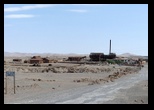
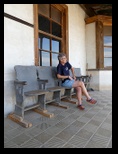
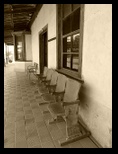
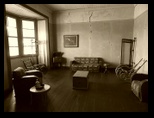
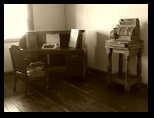
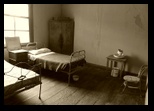
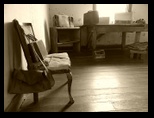
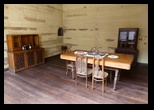
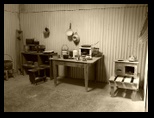
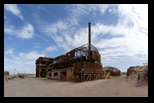


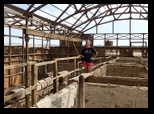
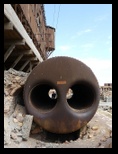
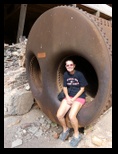
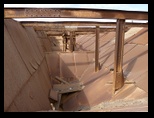
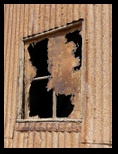



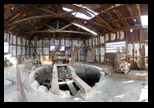
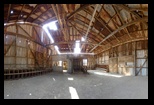
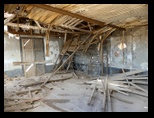
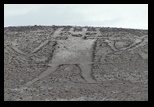
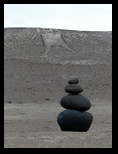
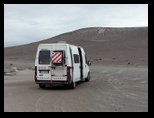

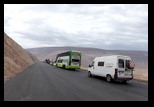
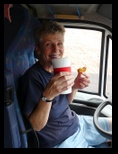
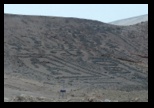


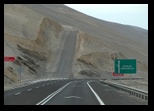


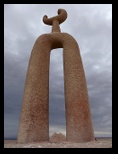

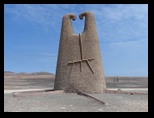
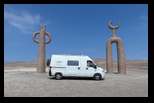
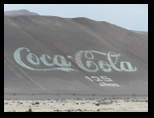


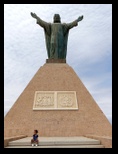
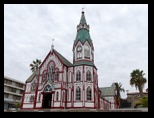
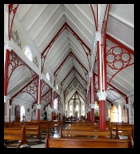

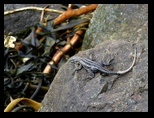
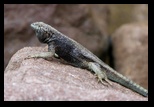
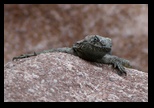
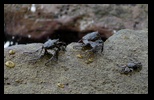
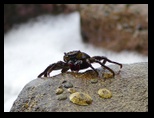

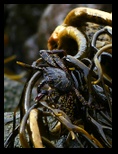
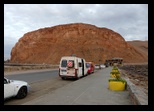
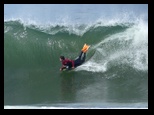
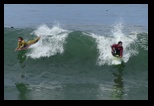
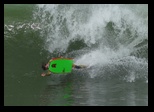
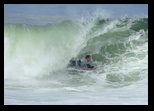
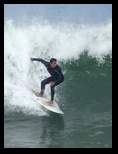
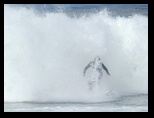

Click on a photo to enlarge it.
The saltpeter mine at Santa Laura is now a National Monument and World Heritage site along with its larger neighbour Humberstone. Naturally occurring nitrate or 'saltpeter' created an early-20th-century boom. Today the Atacama Desert is home to 170 nitrate ghost towns - only one, María Elena, remains open.
Here's a short history of the area from Lonely Planet. "Chile's wealth and prosperity is owed in part to its wrangling of the north in 1879. In the five-year War of the Pacific (1879–84) Chile annexed vast areas of land from Peru and Bolivia. The battles began after Bolivia prohibited a Chilean company from exploiting the nitrate deposits in Atacama, then owned by Bolivia. Chile retaliated by seizing the Bolivian port of Antofagasta and wresting the Tacna and Arica provinces from Peru, thus robbing the Bolivians of all access to the Pacific. This fiercely fought campaign is still celebrated by Chileans with as much gusto as it is bitterly resented by Peruvians and Bolivians. And it's still a prickly thorn in their neighbourly relations today.
The nitrate boom allowed Chile's high society to prosper. British, North American and German investors supplied most of the capital. Railroads revolutionized infrastructure, and the economy boomed. The addition of ports such as Iquique and Antofagasta only augmented Chile's success.
It didn’t last long, though - the invention of petroleum-based fertilizers spelt doom for the nitrate industry and the subsequent bust drove the nation to near bankruptcy, and left scores of ghost towns scattered along the Panamerican Highway. When the nitrate bubble eventually burst, copper, which still propels the Chilean economy, was there to replace it." (Lonely Planet)
When the nitrate bubble eventually burst, copper, which still propels the Chilean economy, was there to replace it.
The ghost towns of Santa Laura and Humberstone were established in 1872 and were at their peak in the 1940s. The development of synthetic nitrates forced their closure in 1960. 3000 workers lost their jobs and the buildings are now ghost towns. Humberstone costs 4,000 pesos per person ($6 per person) but Santa Laura is free.
We spent almost 2 hours wandering around and it was quite amazing. We went into a ranch type building where there were still beds and furniture remaining. Then we went out to the larger buildings where lots of old rusty machinery is still in place. It is quite large and we had the place to ourselves.
The wind blew through the buildings and old corroded metal roof parts creaked loudly. The sounds made it feel like a ghost town and it was quite eerie! The place certainly had atmosphere! But not a place we would have liked to live or work in. The men had to work in extreme heat, battling with sand and dust and thirst. Drinking water was probably like gold dust here.
We really enjoyed our visit - quite a difference to Kirsten's birthday last year when we were on the South Sandwich Islands in the Antarctic. Now she's spending her birthday in the desert in a dilapidated mine but really enjoying it!
The saltpeter mine at Santa Laura
On the drive back to Highway 5 we just took a look at Humberstone from the outside and then drove north to see El Gigante de Atacama (The giant of the Atacama.) At 86m high it's the biggest archaeological representation of a human in the world. Reclining on the isolated west slope of Cerro Unita 14km east of Huara, the geoglyph is thought to represent a powerful shaman. Experts estimate that the giant dates from around AD 900.
We stayed there for the night and after an internet stop the next morning in the nearby town of Huara, we continued north on the Panamerican highway. We were looking for the geoglyphs of Tiliviche along the route but the road looked too sandy. Further north we hit roadworks and a long queue.
We were stuck in the queue for 40 minutes and made ourselves cappuccinos. Some of the truck drivers said they'd been here for less than an hour and they made it seem like a positive thing! As if anything less than an hour was good and normally it would be longer! We only just managed to finish our drinks and the queue started moving.
The first part was almost finished and very good. As we descended into the valley we were overtaken by lots of cars and buses who were obviously in a hurry. We stayed in low gear rather than overheat our brakes. Then we hit very bad gravel stretches with lots of pot holes. There were 93 cars and trucks waiting at the other end of the roadworks! We made note because we will be returning along the same stretch when we start heading back south in about a week.
After the roadworks there was a short stop to check my drivers licence and then the road ascended about 1,000m onto a plateau. We stopped at Presencias Tutelares (several statues that date from 1998) for the night. We were far enough from the highway that we couldn't hear the traffic and it was a very peaceful night.
In the morning we set off after a few photos of Winnietwo and the sculptures and drove into the large port of Arica. The border with Peru is only a few kilometres further north but we would be staying in Chile and going back into Argentina further south. However, when we're close to a border we need to take care and make sure one of us is with Winnietwo at all times.
We did some shopping at Walmart and then drove up to El Morro, an old fort at 110m where there are still cannons on display and a museum. This lofty headland was the site of a crucial battle in 1880, a year into the War of the Pacific, when the Chilean army assaulted and took El Morro from Peruvian forces in under an hour. There were good views over the town of Arica and the port. It was cooler up here so we had a lunch stop.
At 4-15pm we drove back down and went to look at the Catedral de San Marcos because it was built by Alexandre Gustave Eiffel (of tower fame!) by order of the Peruvian president in the 1870s - this part of Chile used to be part of Peru. Then shipped over and assembled on site here in Arica. The entire church is made of stamped and moulded cast iron, coated with paint.
Afterwards we headed out to the Cuevas de Anzota which are about 12km south of Arica along the coast. But 1.2km before the parking area the road was blocked and there was a traffic queue. Due to construction work only 2 buses and 10 cars were allowed at a time. This meant we would have to wait for vehicles to exit and we were 7th in line.
It took 55 minutes for 7 vehicles to come out so that I could drive in but Kirsten had already set off on foot to walk to the caves. We were going to go separately to see the caves anyway so that one of us could keep an eye on Winnietwo so I said I'd wait on the car park for her.
Then I went off to walk to the various caves. The largest had steep steps up to it and back down once you'd walked through the cave. Kirsten didn't do it because of her fear of heights and also because of possible earthquakes so I went up and through it. There was one other cave to go up to and the rest could be seen from a boardwalk. There were no bats but they used to collect Guano (bird poop!) which was used as fertilizer.
In the large rocks along the beach and small bays there were a lot of black crabs and lizards although you could only spot the black crabs if they moved. They were very well camouflaged. It was an enjoyable little stroll and once the construction is finished and there is a bigger parking area and possibly toilets and a small kiosk it would be worth coming down here. The long wait put a lot of people off and a number of cars simply turned around and drove off.
Cuevas de Anzota
We had planned to stay overnight here but obviously that is not possible now, and may not be in the future either, so we drove back along the coast and parked up on a small peninsular. Kirsten made us German Frikadellen (spicy hamburgers) with potato salad for our evening meal and it seemed that we would be safe here. But it was a very, very loud night. We were kept awake by loud thumping music with the same beat coming from various small cars that turned up. It is obviously the party area for the younger crowd.
The next morning Winnietwo was surrounded by litter and we found out that it's party night every night. The younger generation throw rubbish, cans and smash glass bottles along the peninsular. Many older Chileans are employed to pick it all up in the searing heat. They even have to scramble amongst the rocks to try and get all the glass pieces out. Ten truck loads of rubbish are collected every day from the beaches of Arica!!
One of the workers who is 66 years old said the young people don't care and when she asks them not to throw rubbish on the floor or smash bottles they just turn around and say that if they stopped she wouldn't have a job anymore! Maybe they should send school children out to collect the rubbish as part of their education. It might stop them littering in the future. Kirsten thanked her for collecting all the rubbish and she was very pleased.
There beaches here are well visited particularly by surfers and surf boarders who seemed to be having a lot of fun. Arica's reputation for terrific tubes has spread worldwide. It now hosts high-profile championships and tempts surfing film crews to the area. July sees the biggest breaks. The water is cold because of the Humboldt stream so they need to wear wet suits. We drove through Arica to get shopping, water and diesel and left at 2-45pm.
Surfers in Arica